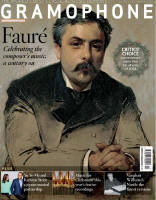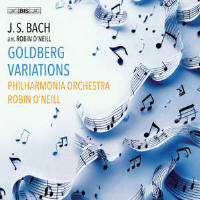Texte paru dans: / Appeared in:
|
|
|
|
|
|
‘Aria with diverse variations for a harpsichord with two manuals composed for music lovers to refresh their spirits’ was the description under which JS Bach’s Goldberg Variations were first published in 1741 by the Nuremberg music engraver Balthasar Schmid. So it’s fitting that conductor and Philharmonia principal bassoonist Robin O’Neill conceived this orchestral reimagining of them during the first Covid lockdown in 2020 when, in need precisely of a spirit-refresher, he immersed himself in Glenn Gould’s recordings of the work, heard instrumental and orchestral sonorities, and was moved to come up with this new transcription for string orchestra with solo flute, oboe and cor anglais, and two bassoons. Some variations are scored tutti. Others are for smaller concertante groups of two, three or four solo instruments. As a whole, it’s highly successful, thanks equally to O’Neill’s unerringly sensitive preservation of the original’s delicacy and lucidity, and to his Philharmonia colleagues’ equally sensitive, light-of-tread playing.
The opening aria is thoroughly beautiful, O’Neill introducing us to his forces and concept by passing the melody every two bars between the woodwind soloists, ensemble violins (make sure you admire their soft blend) or violins plus oboe. Embellishments curl elegantly and tuck smartly, whether from soloists or from unison ensembles; diverse articulation colours the carefully shaped lines, developing the argument. The overall effect is of a polonaise gliding along with such smooth, rhythmic steadiness that you could dance to it, had you the physical strength and poise for its slow tempo.
Onwards, and small-forces highlights are quick to appear. Take the Var 3 canon, presenting as a warmly vibrato’d trio between two violins and a cello; or the following similarly swift passepied for oboe, cor anglais, two bassoons and double bass. While the two aforementioned variations feel very close to Bach’s world, the orchestral numbers spread their wings towards later eras. Take Var 5, over which flute, oboe and two bassoons play out a lilting conversation to steadily running violin and viola figures, which is a ‘character piece’ that sounds slightly Mozartian. Or Var 23, a playfully tiptoeing, counterpoint-rich scherzando full of pizzicato scales, which has me thinking of Britten’s The Young Person’s Guide to the Orchestra every time. The chromatically rich ‘Black Pearl’ Var 25 leans even further than Var 23 towards Mozart, after which Var 26 is a glorious creation allowing upper strings to showcase their ensemble virtuosity via rapid, weightlessly whirling and circling passagework against a perkily elegant woodwind sarabande, all pushed and carried by a lower-strings bass line tripping along with a distinctly jazzy bounce. The musicians then imbue the Aria da capo with a very strong sense of homecoming and renewal.
Genuinely, a joy of a listen: an entirely new, quietly bold creation that exudes intimate knowledge and love of its raw musical material and chosen instrumental forces, performed by O’Neill’s Philharmonia colleagues with palpable close-knit pleasure. |
|




